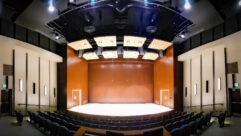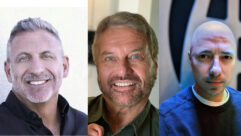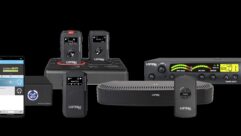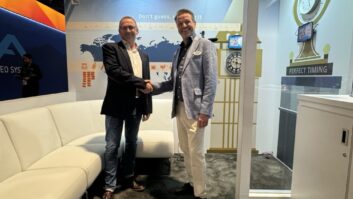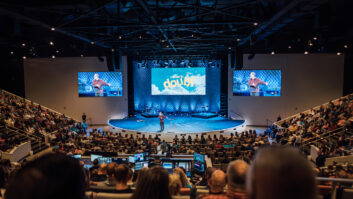Ushering in a New Era: Sound reinforcement for a colossal television eventdemonstrates how to succeed in China by balancing technology with diplomacy.
Nov 1, 1997 12:00 PM,
Bruce Borgerson
Business opportunities in China are as expansive and varied as the Chineselandscape. For anybody involved in sound reinforcement – manufacturer,consultant or international contractor – the Chinese market offersseemingly unlimited growth potential.
What do you need to succeed in China? The basics are obvious – the latestin Western technology, solid marketing and a good translator. It also helpsto cultivate patience, flexibility and diplomatic finesse. An illustrativecase in point is the experience of sound reinforcement professionals fromCalifornia and Hong Kong involved in a recent historic event, the Hong KongReturn Celebration in Guangzhou.
Once Canton, now GuangzhouFormerly known as Canton, Guang-zhou is a bustling commercial centersituated 90 miles (145 km) north of Hong Kong. On one hand, Guangzhou is avibrant example of the new Chinese economy. Mirrored skyscrapers sproutlike weeds, motorbikes jam neon-lit shopping districts, high-decibelnightclubs pulsate to rock beats, and inhabitants engage in a feverishpursuit of wealth that would make Adam Smith blush.
Yet somehow, this overheating capitalist engine functions within thechassis of an omnipresent Chinese communist bureaucracy. It’s verydifficult to do business in China without dealing with theministry-of-something-or-other at one or more levels. This is particularlytrue if you are dealing directly with government entities.
In our example, the entire Hong Kong Return Celebration was created andadministered under official government auspices. It was sponsored by theCity of Guangzhou with overall production responsibility assigned toGuangzhou Radio Broadcasting (GRB). The one-hour musical extravaganza wouldbe telecast throughout China by the central government network (CCTV), withsimultaneous satellite feeds to Chinese communities in 84 other countries.
The scope of the planned production was immense, even by Chinese standards:featured soloists would be backed by a 250-piece orchestra, a choir of1,997 voices (members drawn from throughout China) and 97 pianists seatedbehind gleaming black concert grand pianos.
The original plan: outdoorsGuangzhou officials naturally wanted their celebration to fall within ashort period after the official June 30 handover ceremony, a date fixed bytreaty back in 1898. Also, to accommodate an appropriately impressiveaudience, they wanted to stage the event in their city’s 80,000-seat TianHe Stadium. Accordingly, the concert spectacular was set for the evening ofJuly 11 in the open air stadium despite the fact that this particular datefell in the middle of southern China’s notorious rainy season.
After a preliminary assessment of the site, the officials in chargediscovered that the magnitude of the concert’s sound reinforcementrequirements far surpassed the capabilities of local suppliers. To providea suitable system, Guangzhou Radio Broadcasting called on a Hong Kongdistribution firm with considerable experience in serving the mainlandmarket: Advanced Communication Equipment Company, Ltd. (ACE).
“We were originally contacted in early March about supplying a system,”says Bingo Tso, director of audio at ACE. “We are not a sound rentalcompany, and we had some misgivings about using an outdoor system at thattime of year. But we proceeded with a system design based on the overallrequirements given us by Guangzhou Radio.”
In most respects, ACE was well suited to the task. The company had beeninvolved in the mainland China market for nearly 17 years, supplyingsystems large and small – everything from club disco systems to thePeople’s Hall in Beijing and the Shanghai Opera House. ACE maintains anextensive system design and technical support department to assistcustomers in meeting their requirements and to help local contractors withcomplex installations.
Working with colleagues Terence Lee and Nicholas Kirsch, Tso set aboutdesigning a system that would accommodate the sprawling production and thencommunicate it effectively to an audience of about 60,000. From the outset,the ACE team was fully cognizant that this was primarily a broadcast event;they had to make sure that sound was directed away from broadcastmicrophones and that loudspeaker clusters were as small as possible to stayclear of probable camera sight lines.
HLA supplemented by arrayBecause tight pattern control and high efficiency were both of paramountimportance, the ACE design team initially specified a system based on thenew JBL HLA Series.
“We had seen the HLA Series on a trip to JBL’s California headquarters inJanuary,” says Tso, “and we were very impressed with its capabilities.Because of the high profile of this event, we wanted to have the verylatest speaker technology at our disposal.”
After consulting with JBL’s Asian regional sales manager, Byron Bishop, Tsodiscovered that because of high worldwide demand, HLA speakers would not beavailable in sufficient quantities to cover all the system requirements.Consequently, the final stadium system encompassed two main towers with HLAsystems supplemented by satellite towers with JBL Array Series 4983 and4984 loudspeakers. System layout and coverage patterns were establishedusing JBL CADP2 software, and Crown amplifiers were specified with totalrated output of 110,000 W.
Throughout the early design stages, ACE engineers consulted theircounterparts at Guangzhou Radio Broadcast to make sure all systemrequirements were understood and to ensure that the specified design wouldnot interfere with the radio or television broadcast in any way.
Although the depth of technical expertise at ACE goes beyond that availablefrom most equipment distributors, the company had limited experience inlarge-scale concert sound reinforcement rentals. Therefore, ACE called onDave Revel of the California-based consulting firm DR Audio to assist inthe final design and to provide on-site supervision of system deploymentand calibration.
Wet predicted, wet it wasAbout two weeks prior to the show, long-range weather forecasts indicated aprotracted spell of heavy rains for the days leading up to the event. Thepredictions proved remarkably accurate.
“We had pouring rain constantly right up to two days prior to the event,”Revel recalls. “That weather would have made outdoor preparations for sucha huge event virtually impossible.”
Event organizers called an emergency meeting of all parties involved.Following the typical Chinese authoritarian-consensus model, a decision wasreached: the event would be moved indoors to the 8,000-seat Tien HeColiseum. The scope of the production would not be changed. Because theperformers would require over half the space in the smaller venue, however,two performances would be held, one to be broadcast on Friday the 11th anda second identical show the following night.
“That change meant about five days of working through the night,” says Tso.”We had already shipped all the equipment to Guangzhou, and we had finishedputting up one speaker tower. Then everything changed. It was unfortunate,but we had to do it.”
Production drawings for new venue showed the orchestra, choir and pianoscovering about 80% of the floor and all but about 2,500 seats. New systemdesigns were implemented immediately with Revel’s doing much of theredesign work on his laptop while flying over the Pacific.
Front end and monitorsThe selection and placement of microphones was handled exclusively by theGRB staff. The orchestra and choir were picked up by a variety ofmicrophones from Neumann, Beyer, and Bruel and Kjaer. Soloists and emceesused wireless systems from Beyer and Sennheiser; Crown PZM microphones wereplaced inside the pianos.
A two-way microphone split sent signals to the Studer and Soundcraftconsoles in the CCTV OB van as well as to the ACE-supplied consoles at thehouse mix position. Here, Spirit four-bus and eight-bus boards were usedfor submixes of piano, choir and orchestra with outputs feeding the masterFOH console, a Soundcraft K-3. A separate Spirit mixer created the mix forradio broadcast and archival recording, accepting pre-mixes from the othersubmixers and the master console. Signal processing gear included graphicequalizers, compressor-limiters, and digital delay lines from dbx, DOD andLexicon.
ACE also provided an extensive stage monitoring system based upon aSoundcraft SM-12 console and a variety of JBL loudspeaker systems – EON-10self-powered loudspeakers (for the vast piano stages), 4894 Array Series(for the choir), and MR904, MR905 and SR4074A units for orchestra andsoloists. Although unquestionably essential in the vast outdoor setting,the need for extensive monitoring became an issue of dispute following themove indoors. For example, the orchestra conductor banned all monitors fromhis realm, and use of monitors was restricted elsewhere to an extent thatultimately hampered the performance, according to Revel.
“With such a vast performance area, there were significant signal delaysamong performers at extreme ends,” he notes. “A lack of monitors could leadto noticeable timing problems for some of the musicians.”
Differences of opinion also surfaced regarding the precise layout andsignal patching strategy for the FOH and monitor systems. It seems ACE andGRB had developed different approaches independently. In the end, the GRBapproach took precedence, with some minor modifications based on ACEsuggestions.
Negotiating the cluster designThe sudden shift to the indoor venue generated some unforeseen issuesregarding configuration of the main house loudspeaker clusters.
“Cluster configuration was crucial because of the unusual proximity to theaudience,” says Revel. “In venues this size, the cluster normally would beat least 70 feet to 100 feet (21 m to 30 m) away from the raked seatingarea, but here, we had to put them within 20 feet (6 m) of the nearestseats because the performance area occupied virtually the whole floor. Webarely had room left for the mix position.”
ACE’s initial recommendation called for two flown clusters of eight HLA4895 full-range systems with two more 4895s on the floor along with three4897 subwoofers. For valid production reasons, however, GRB’s productionmanager and technical director, Mr. Peng, preferred a system with nocabinets placed on the floor. To accommodate this request, ACE modified the2 x 4 cluster design to incorporate only six 4895 mid-high units along witha pair of 4897 subs. Two variations were tried, one with the sub units atthe outside of the top row of four, the other with the two subs in thecenter of the lower row. Both configurations were flown and the coverageresults carefully plotted on a test rig consisting of an Earthworks M30calibration microphone, Ivie IE-30A portable analyzer, and JBL SMAARTsoftware running on an IBM Thinkpad 365x. Unfortunately, both solutionsexhibited uneven coverage and deficiencies in mid- and high-frequencyinformation at different points in the raked seating area. Remedies wereattempted using various EQ and crossover changes, but all proved futile.
Finally, after several rounds of courteous negotiations, Mr. Peng reviewedthe test data and concluded that the overall production was best served byflying eight 4895 mid-high units per side, which would provide more evencoverage to all seats. At the same time, Revel and the ACE engineers wereable to accommodate Peng’s production requirements to a greater degree byremoving all 4895s from the floor and placing only two 4897 subs on thedeck.
According to Revel, the HLA Series systems proved invaluable insuccessfully configuring a satisfactory system under last-minute pressurescomplicated by equally valid yet conflicting requirements for placement.”The 4895 exhibits extremely good pattern control, so we were able todirect the sound where it was needed in the audience and avoid washingeither into areas that had reflective surfaces or down into the orchestramicrophones. That gave us plenty of gain before feedback, even with so manyopen microphones.”
In addition, says Revel, the HLA’s light weight and integrated flyinghardware proved a godsend. “It was very easy to raise and lower theconfigurations, to change out the boxes or turn them upside down and flythem again. That part was remarkably easy, and we wouldn’t have been ableto try as many cluster combinations with other speaker systems. As it was,HLA allowed us to keep trying until we found a solution acceptable toeverybody.”
Flat bows to the “Guangzhou curve”With cluster configuration fixed, Revel and the ACE crew turned theirattention to fine-tuning coverage patterns and calibrating the system. Whenboth clusters were flown (trials were done on one side only), Revel noticeda 3 dB boost in the center seats, a result of the short throw from clustersto the seats and the tight, overlapping patterns of the interior 4895units. The coverage was balanced out appreciably by splaying the interiorcabinets 30 degrees and splaying the outer ones at 40 degrees to cover thecorners.
“We could have done even better by moving the clusters physically,” notesRevel, “but we were unable to do so because of the physical rigginglimitations of the venue grid.”
With all loudspeakers in place, JBL’s SMAART system was employed to producea flat transfer function from input to output. All adjustments were madewith the DSC280 system controllers. Once the system was determined to beaccurate within narrow parameters, it was turned over to the GRB staff forsubjective listening tests using music from commercial CDs – orchestral, TVand movie themes, and Chinese opera. At the request of the Chineseproduction crew, some slight alternations were made, most notably a rise ofabout 3 dB/octave below 400 Hz.
Despite this calibration by committee, Revel was quite pleased by theoverall results. “This was my first experience with HLA in a large concertsetting, and I was impressed with the ability to predict a coverageresponse using my computer drafting techniques. I found the cluster designexhibited the planned response almost exactly, which is something I havenot experienced to nearly the same degree with other loudspeakers. Thatdiscovery was quite exciting.”
Two days before the performance and only one day before final rehearsals,the system was fully commissioned. ACE received full approval on allaspects from Mr. Peng and other key GRB production officials, but not fromCCTV.
In TV, the camera rulesPrior to the change in venue, according to Tso, CCTV had reviewed thelocation of loudspeaker towers and given approval to ACE’s stadium design.
Unfortunately, the sudden change of venue occurred almost simultaneouslywith the Hong Kong handover ceremonies. All the key CCTV productionofficials were tied up in Hong Kong, and they arrived only one day beforefinal dress rehearsal in Guangzhou.
“We flew our clusters so that a camera at the back of the seating areawould have a clear shot to the top of the choir riser,” says Revel. “Butthey put murals above the choir, clear to the ceiling. There was no way wecould get a cluster high enough to clear the murals and remain effective.”
When CCTV production officials arrived, they conferred briefly with eventproduction officials. ACE representatives were not invited. The decisionwas quick and final: the clusters would come down for both the dressrehearsal (not televised but used to set up camera shots) and the broadcastperformance.
“Considering they were down on the floor, the HLA’s did a creditable job,”says Revel. “Coverage was quite good in the front VIP area, but of course,we lost the back corners completely.”
Fortunately, all of the hard work and delicate negotiations were rewardedon the following night. The Saturday performance was not televised, so theclusters were free to fly again. The resultspleased everybody involved.
“The top officials in the VIP section were amazed by the quality of thesound,” says Bingo Tso. “A CCTV producer, the one who ordered the clustersremoved, thought that the sound was so good that he suspected we wereplaying a prerecorded tape!”
According to Tso, cultural events in China fall under the aegis of theMinistry of Propaganda. The morning after the final performance, theminister invited the ACE crew to a breakfast meeting. The ministerexpressed personal satisfaction by offering to book ACE for two largerevents in 1999: the return of Macau and celebration of 75 years of theCommunist Party in China.
“We are not a sound rental company,” Tso said, “but if the conditions areright, we may do it. In the meantime, we are working with some keycustomers to establish a rental company with an HLA system sufficientlylarge for this type of event.”
Technology appreciated, patience rewardedBefore removing the system, ACE conducted a special seminar to introducethe HLA Series to dealers, contractors and government officials from as faraway as Shanghai and Beijing. After ACE had explained the technology, thestaff fired up the system for a series of listening tests from CD sources.The top crowd pleaser during the session was the theme from The MagnificentSeven as played by Eric Kunzel, and Cincinnati Pops. (One can onlyspeculate on how many knew that the movie was based on a Japanese film, TheSeven Samurai.)
The results were again most gratifying, according to Tso. Although theimmediate project at hand was subject to a string of frustrating changesand system performance may have been limited slightly by diplomaticcompromises, the overall outcome was rewarding to all involved.
“Being a Hong Kong company, we wanted to be part of this historicoccasion,” says Tso. “It was difficult, but now, all the governmentofficials are happy with the results. This has opened the door for futurebusiness.”




